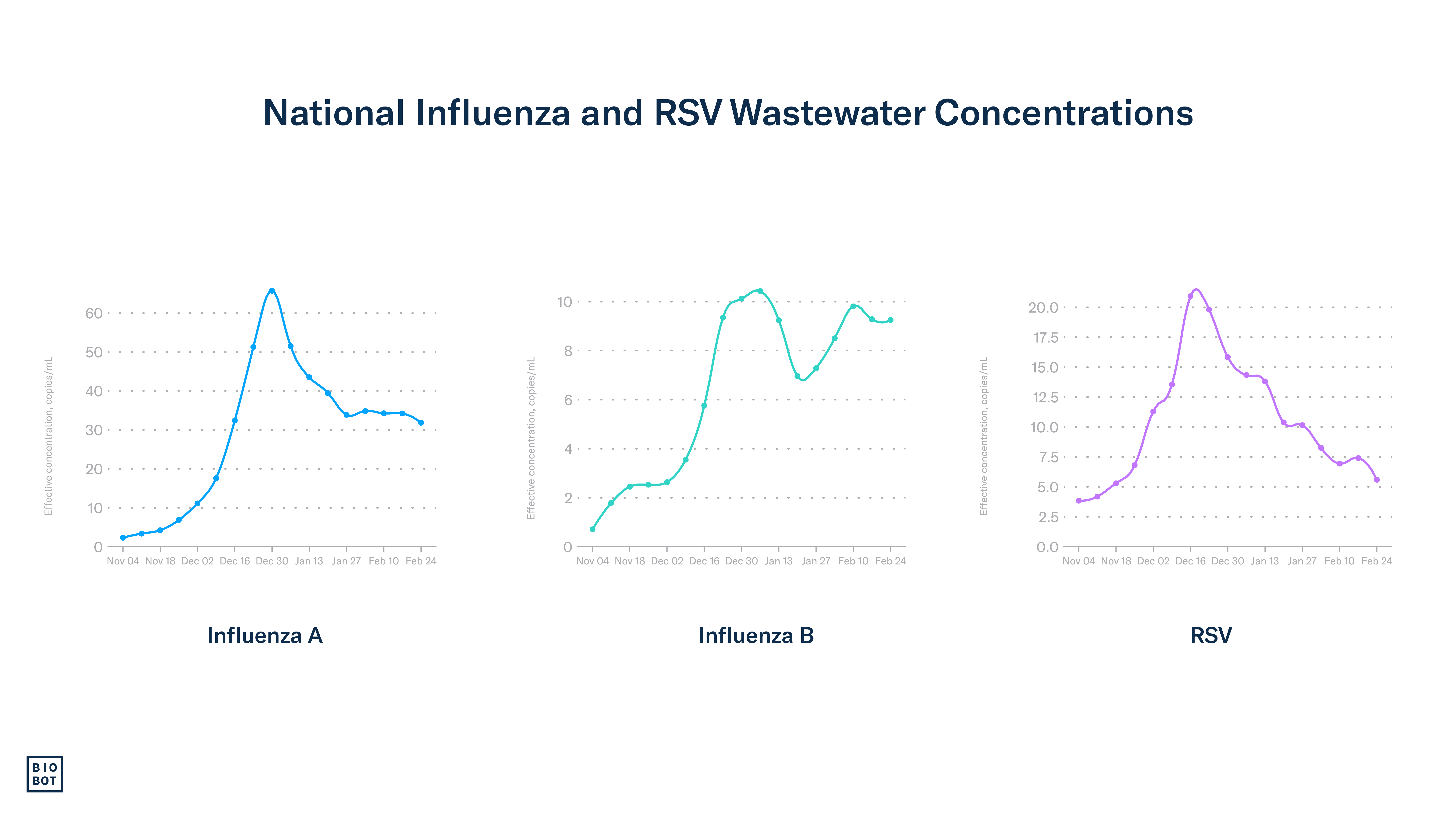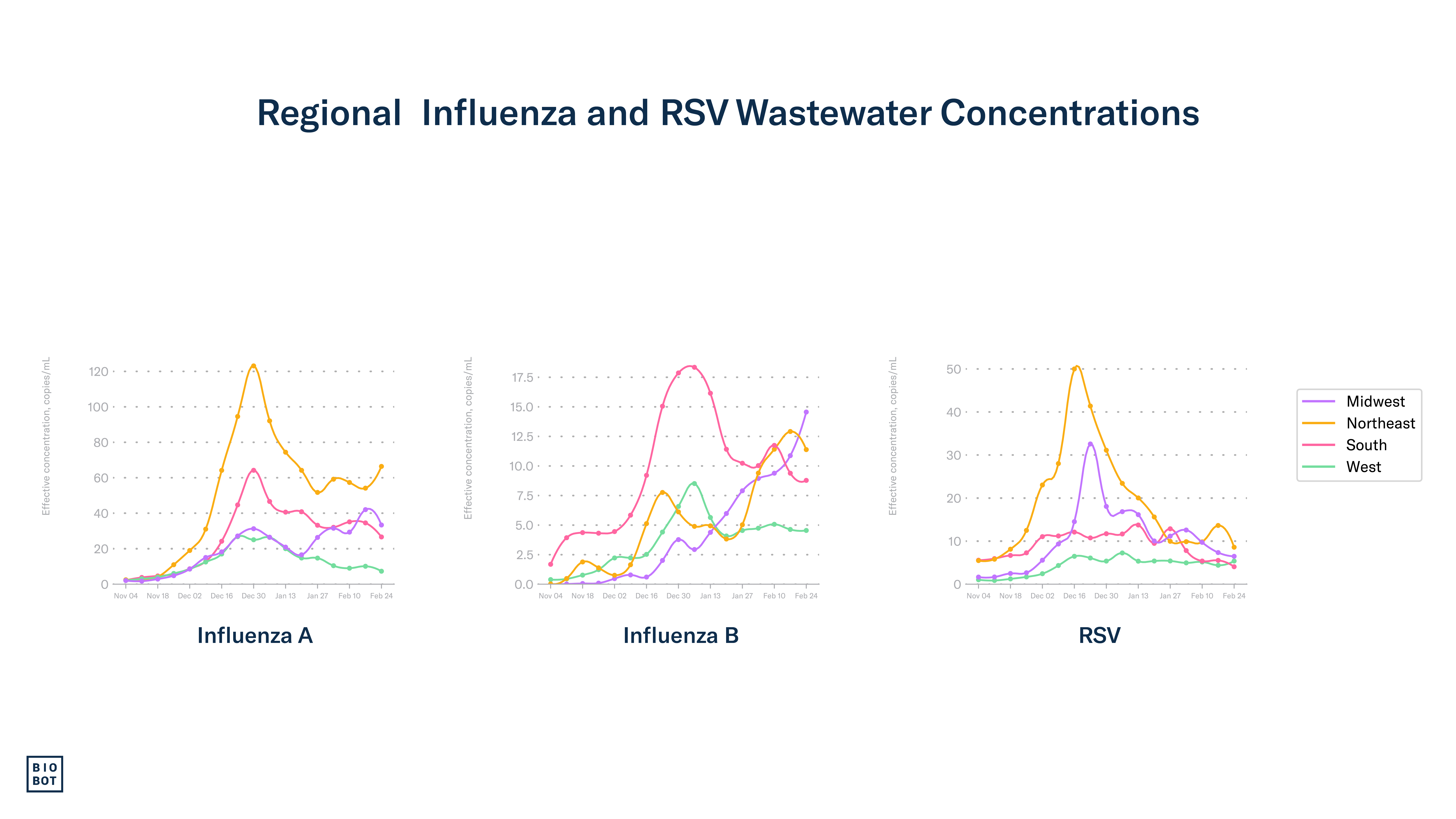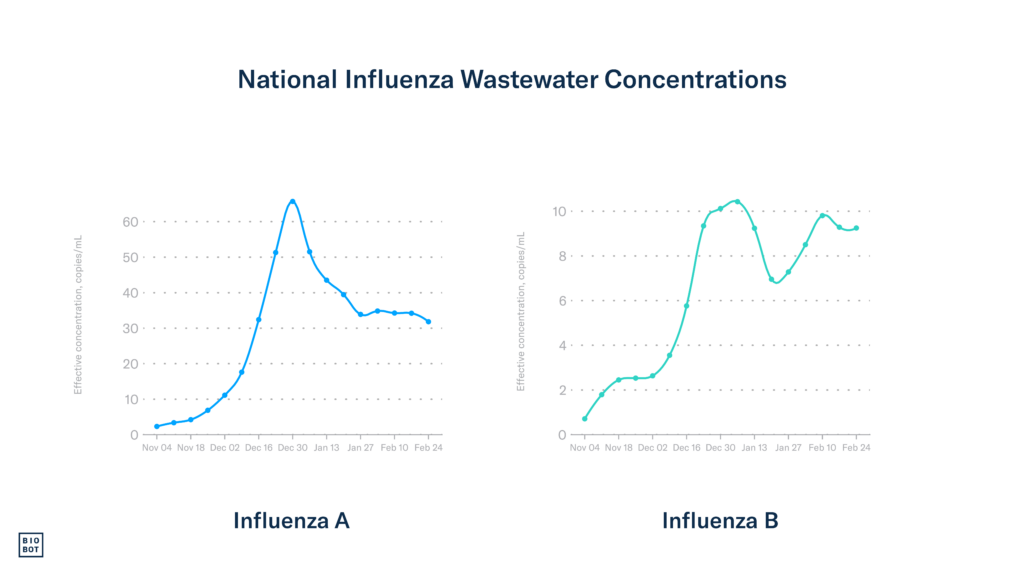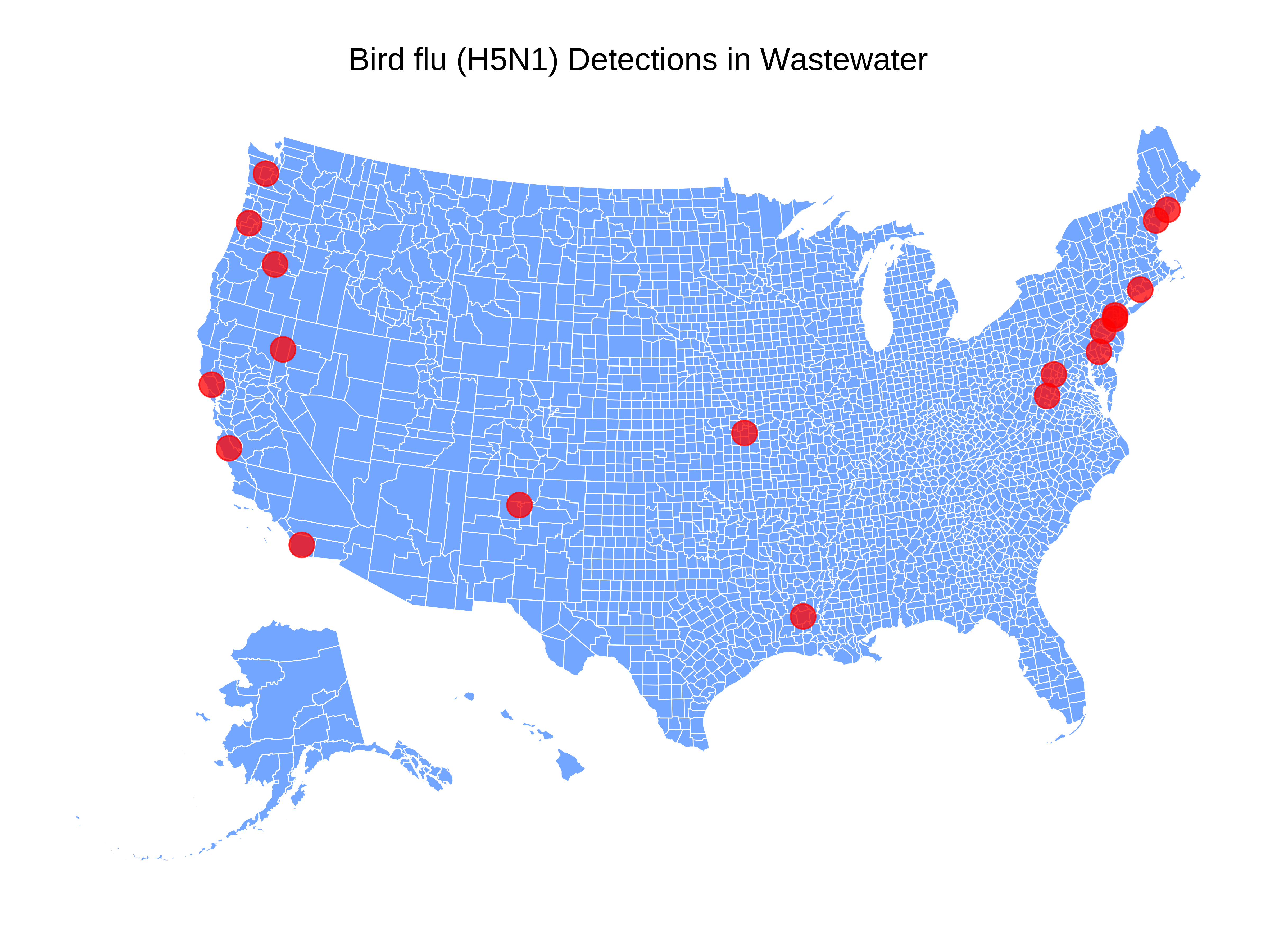At Biobot, we analyze wastewater across the country for various infectious disease pathogens....

Respiratory Virus Risk Reports
Comprehensive Insights for COVID-19, Influenza, and RSV
COVID-19, Influenza, and RSV Wastewater Monitoring in the U.S. | Week of February 26, 2024
This respiratory season, we are analyzing wastewater for the presence of respiratory syncytial virus (RSV) and influenza virus (types A and B). Together with COVID-19, these three pathogens are outsized contributors to our seasonal respiratory illness burden. In this data series, we’ll guide you through the wealth of data we’ve gathered from our Biobot Network of national sampling sites, aiming to shed light on emerging trends in respiratory virus activity and community viral load. Our goal is to equip you with information to make informed decisions, especially as we approach the holiday season and gather with family and friends.


Data Note: Samples are collected from participating locations and processed by our lab team on a rolling basis. Each point on the figure represents the weekly average concentration from Sunday – Saturday (corresponding to the MMWR week), aligned to that week’s Saturday.
Contributors

Marisa Donnelly, PhD
Public Health Partnerships Epidemiologist

Max Imakaev, PhD
Data Scientist
Previous Risk Reports
Summary: Week of 2/26/24
Data from Biobot’s national wastewater network and clinical disease monitoring show that all three major respiratory viruses (COVID-19, influenza, and RSV) showed some positive signs of declining activity. National average wastewater concentrations for RSV, influenza A, and SARS-CoV-2 all declined during week 8. Most clinical metrics for the three major viruses also showed some signals of a declining respiratory illness burden. We aren’t quite yet through the respiratory illness season, but we are getting closer to its end.
The Bottom Line: As we get closer to the end of the respiratory virus season, viral activity levels remain elevated. It is still an important time to reduce contact with others if you are feeling ill, consider wearing a mask in crowded environments, and keep up to date with vaccines and boosters. Taking these measures can help keep you and your loved ones healthy.
National Outlook
RSV
Nationally, RSV wastewater concentrations continued to decline in week 8, going down by 41%. National RSV concentration averages are now at the levels we observed in mid-November.
Clinical RSV metrics also continued to decline in week 7. As of February 17th, the percentage of PCR tests that are positive (test positivity) for RSV continues to decrease, going down from 5.1% the previous week to 4.3% currently. Hospitalization rates also continue to decline nationally and for all age groups.

Influenza
Data through week 8 show that wastewater concentrations for influenza A, which is driving most clinical burden in the US, began declining again, going down by 7%. On the other hand, influenza B concentrations did not change at all during week 8 and remain relatively high.
While clinical metrics are still a bit of a mixed bag, there are some welcome signals that influenza activity could be declining. In good news, test positivity began declining again during week 7, going from 15.7% in week 6 to 14.8% currently. Hospitalization rates remained mostly consistent with around 10,500 hospitalizations due to flu during week 7. The percentage of outpatient visits for flu-like symptoms – typical in flu, RSV, and COVID-19 patients – also did not change, remaining at 4.5% in week 7. With some declines in wastewater concentration and test positivity, influenza A is showing some positive signs that it is headed towards reduced activity again. We hope this trend continues as this influenza season is proving to be long and volatile.

COVID-19
Wastewater data show that COVID-19 activity and community viral load decreased significantly in the previous week. As of February 24th (week 8), the national SARS-CoV-2 wastewater concentration average is 687 copies/mL.
In great news, all of the major national clinical COVID-19 metrics are trending downward during week 7. COVID-19 hospitalizations dropped from more than 21,000 in week 6 to just under 19,000 in week 7. The national COVID-19 test positivity rate declined from 9.4% in week 6 to 8.1% in week 7. Deaths also declined by 11.1%, currently representing 2.4% of deaths in the US. These declining trends in wastewater concentration and clinical metrics are great news and indicate that we are moving in the right direction toward the end of this COVID-19 surge.
Regional
The South
RSV: RSV wastewater concentrations declined during week 8 in the South and are now at the lowest levels we’ve seen since we began testing in late October. During week 7, RSV test positivity levels continued to decline, currently at 2.4%. This value is similar to what we saw at the beginning of the RSV season in early September, signaling that RSV activity in the South is low.
Influenza: In good news, influenza A and B wastewater concentrations declined in the South during week 8. Most Southern states also saw decreases in influenza-like illness outpatient visits during week 7. Unfortunately, outpatient visits increased in Washington DC, which is currently in the Very High influenza-like illness activity level.
COVID-19: In good news, SARS-CoV-2 wastewater concentrations significantly decreased in the South during week 8. During week 7, however, clinical data was a mixed bag. Six states in the South saw increases in COVID-19-associated hospitalizations (Alabama, Georgia, Kentucky, North Carolina, Tennessee, and Virginia), while the others saw decreases or no change. We hope that following the decreases in wastewater concentrations observed in week 8, that clinical metrics will begin declining in response.
The Midwest
RSV: RSV wastewater concentrations continued to decrease in the Midwest during week 8, and they are currently at similar levels observed in early December. Test positivity during week 7 also continued to decline, dropping down to 6.2%. This is currently the highest test positivity value for all US regions and suggests that RSV activity levels in the Midwest remain elevated.
Influenza: In good news, influenza A wastewater concentrations began declining again in the Midwest following a spike the previous week. Unfortunately, influenza B concentrations continued to increase during week 8. Clinical data also shows that the Midwest’s respiratory disease burden is quite elevated. During week 7, half of Midwest states saw an increase in influenza-like illness outpatient visits, with Michigan and Missouri having the largest increases.
COVID-19: SARS-CoV-2 wastewater concentrations in the Midwest remained stable from week 7 to week 8, currently at 843 copies/mL. In mainly good news, all but three Midwest states (Illinois, Minnesota, and Kansas) experienced a decline in COVID-19-associated hospitalizations.
The Northeast
RSV: In the Northeast, RSV wastewater concentrations declined during week 8. Current levels are similar to what we observed in mid-November, close to the beginning of the season. RSV test positivity also continued to decline during week 7, currently at 3.1%. These low values signal that the Northeast is getting close to the end of its RSV season.
Influenza: Unfortunately, influenza A concentrations increased in the Northeast during week 8. In better news, influenza B concentrations decreased. Most states in the Northeast experienced a decline in Influenza-like illness outpatient visits during week 7. Currently, most states are in the low or moderate influenza-like illness activity levels, however there are still 5 states in the High activity level. Overall, influenza activity appears to be relatively high in the Northeast.
COVID-19: SARS-CoV-2 wastewater concentrations declined in the Northeast during week 8, with current concentrations at 1,013 copies/mL. The Northwest also continues to show some good signs of continued decline in COVID-19 disease burden, with all but one state (Pennsylvania) experiencing a decrease in COVID-19-associated hospitalizations during week 7. We hope these downward trends continue.
The West
RSV: RSV wastewater concentrations slightly increased in the West during week 8, but remain low overall. In good news, RSV test positivity began declining in the West again, currently at 4.2%. The low wastewater concentrations and continued declines in test positivity suggest that we likely have a couple more weeks of the RSV season in the West but that we are getting closer to the end.
Influenza: In the West, during week 8, wastewater concentrations for influenza A decreased, while concentrations of influenza B remained stable. Unfortunately, during week 7, most states in the West experienced a slight increase in influenza-like illness outpatient visits. New Mexico and Wyoming are still in Very High influenza-like illness hospitalization levels, and Alaska and Nevada saw significant increases. We hope that these trends will reverse and start decreasing again soon.
COVID-19: In good news, SARS-CoV-2 wastewater concentrations continued to decline in the West during week 8, currently at 357 copies/mL. In more good news, all Western states except three (New Mexico, Oregon, and Hawaii) experienced a decrease in COVID-19 associated hospitalizations. These decreases in clinical and wastewater trends signal that the West continues to get closer to the end of the current COVID-19 surge.


Footnotes:
Wastewater data from Biobot Analytics for RSV, influenza, and SARS-CoV-2 are through February 24, 2024 (MMWR week 8). Clinical data on testing, hospitalizations, and emergency department visits for RSV, influenza, and COVID-19 are from the Centers for Disease Control and Prevention. Updates to clinical data for RSV, influenza, and COVID-19 are through February 17, 2024 (MMWR week 7).






